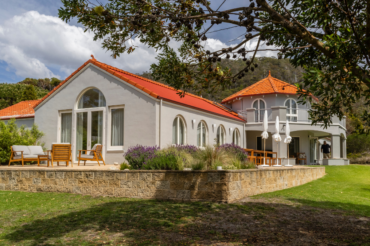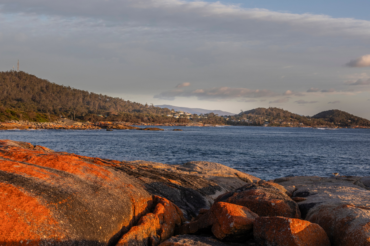
Central Victoria’s climatic excesses are just the kind of challenge nurseryman David Glenn relishes. David prefers not to battle with the climate and instead has establishing a benchmark dry climate garden as an adjunct to the nursery.
Even though it’s mid-November, nurseryman David Glenn has been up at sparrows, watering the frost off the tomatoes. It seems absurd as in a couple of months he’ll be dealing with the opposite extreme: summer temperatures at Lambley, his nursery and garden at Ascot in the central Victorian central highlands, frequently hit the low 40s and the hot, dry wind gusting across the paddocks desiccates everything in its path. Tomatoes (more about them later) aside, David prefers not to battle with the climate and instead has spent the best part of 25 years establishing a benchmark dry climate garden as an adjunct to the nursery.
At the time of Australian Country’s visit, Lambley has the welcome mat out in spring carnival colours, beginning with the 400-metre driveway lined with flowering cherries underplanted with myriad blue agapanthus. Behind the two-metre hedges on the right is the dry-climate showpiece, and an equally splendid kitchen garden interspersed with a colourful riot of perennials is on the other side. Behind that is an allée of ornamental pears with salvias for groundcover. “There are 20,000 crocus planted beneath them so there’s always something flowering,” David explains. “Lots of visitors bring picnics to enjoy in the shade.”

Drystone walls surrounding the 1860s bluestone Burnside homestead screen the private areas, with greenery enveloping the house and a vast park-like expanse guarded by various fruit trees off to one side. In deference to the region’s cherry farms of bygone days, David planted a range of cherry varieties and last year they rewarded him “with so much fruit we didn’t bother netting because the birds couldn’t possibly eat it all”. Slightly further afield are two of the most significant trees in the garden, both dating probably from the 1870s when John Lester, later the district’s shire president, first established the garden.
The towering Sequoiadendron giganteum and a Pinus nigra bear testimony to a time when gentlemen with connections had access to plants imported for botanic and other public gardens.
David hastens to add that the property he and his wife, artist Criss Canning, bought in 1987 bears little resemblance to the present spectacle. “It had been constantly farmed since 1838 so the soil was completely compacted,” he explains. “Basically we started with 20 acres of horehound, pademelon and thistles. But as Criss said, ‘if it grows good weeds, the soil can’t be all bad’, so we set to work, digging it up, adding lime to counteract the acidity, composting and mulching to inhibit the weeds and retain any moisture.”

David adds that the garden has been recently enjoying something of a reprieve from the drought that persisted for almost 15 years after they took up residence. When it finally broke four years ago, it did with vengeance, and vast areas, including thousands of dollars worth of mulch were washed away.
“It took a year for me to find the energy to start all over again,” he says. “But that’s this part of the world for you. One extreme to another.”
It’s a far cry from the landscape in the English East Midlands horticultural village of Lambley where David grew up. “My uncle had a nursery which my cousin still runs,” he recalls. “Another uncle was the head of parks and gardens and my dad was a jobbing gardener in Nottingham and occasionally I used to help him out. I was good at sport as a lad and I worked as an instructor for the YMCA until I discovered I much preferred flowers to adolescent boys.”
In 1962, at the bulletproof age of 19, he took off for adventure and Australia via the overland route through the Middle East. “I eventually arrived in Darwin as that was as far as I could afford to fly from Singapore,” he says. “From there I hitch-hiked to Mount Isa, then Cloncurry. Finally I got a lift with a bookmaker who was going to the Townsville races, where I won £25 which got me to Brisbane and eventually to Melbourne.” From there, he worked all over as a gardener, including a stint in Sydney for Swanes’ nursery and finally to the Dandenongs in the early ’70s where he started his own wholesale propagating business. Along the way he met and married his first wife and raised a family, including son Ric, who has carved a stellar career for himself and is now head gardener for the Cadogan Estate in London (watch out for his story later this year).

Following the end of his marriage, David says he wasn’t looking for love when he met Criss, who came to his garden looking for flowers to paint. “She invited me to come and see the painting when it was finished, but I never took her up on the offer,” he recalls. “Then I ran into her at the post office and I remembered her name. That was odd, because I don’t remember anyone’s name.” The rest, as they say, is history and shortly after David and Criss began the two-year hunt, which culminated in their moving to Burnside.
As a sign at the entrance to the dry garden explains, this section is only watered three to four times a year. David has scoured the world for plants that thrive under such harsh conditions and the list includes offerings from locations as diverse as Mexico, California, the Mediterranean, South Africa, Turkey and the Canary Islands. The garden itself is a profusion of colour and growth and an inspiration to gardeners from similarly arid parts of Australia including western NSW and Queensland, South Australia and Western Australia.
“I chose olives rather than eucalypts because it’s difficult to grow an understorey under eucalypts,” David says. “They came as advanced plants but they needed to be watered and fertilised well at the start or they would have sulked for 20 years. But now they are thriving and the birds love them. The frosts turn the fruit to mush, which means we have to rake the paths twice a week. But they give the garden a lovely framework.” Spiky echiums add drama and yuccas their sculptural splendour, while lilies and alliums provide bursts of colour. Eryngium flower for so long they “almost become boring”.

As David explains, the vegetable side of the garden is as much a laboratory as a kitchen garden as he test runs all seeds in his catalogue, before offering them for sale. He adds that, contrary to current trends, he offers very few heirloom varieties. “I simply believe that many heirloom varieties, particularly tomatoes, are second rate,” he says. “Much of the seed we sell is hybrid, developed for its flavour, excellent germination rate and disease resistance. It’s not genetically engineered, it’s selectively bred. Our seeds are generally quicker to reach harvesting stage and slower to bolt than heirloom varieties.”
Adjacent to the fruit trees and vegie beds are a riot of flowers, from stocks, poppies and sweet peas to tulips, irises and ranunculus interspersed with wallflowers. Zinnias and sunflowers vie for attention with masses of roses including Delbards — Henri Matisse and Alfred Sisley.
David’s day begins when he delivers a big bunch of whatever study Criss is working on to her studio, and ends when he joins her to mull over the day’s achievements and prepare dinner with whatever bounty the vegie garden has provided that day. “Our lives are so interwoven that sometimes it’s hard to know where work ends and life begins,” he says. “Of course there’s hard work involved, but most of the time it doesn’t feel like it.”
For more information visit lambley.com.au.
By Kirsty McKenzie, photography Ken Brass










